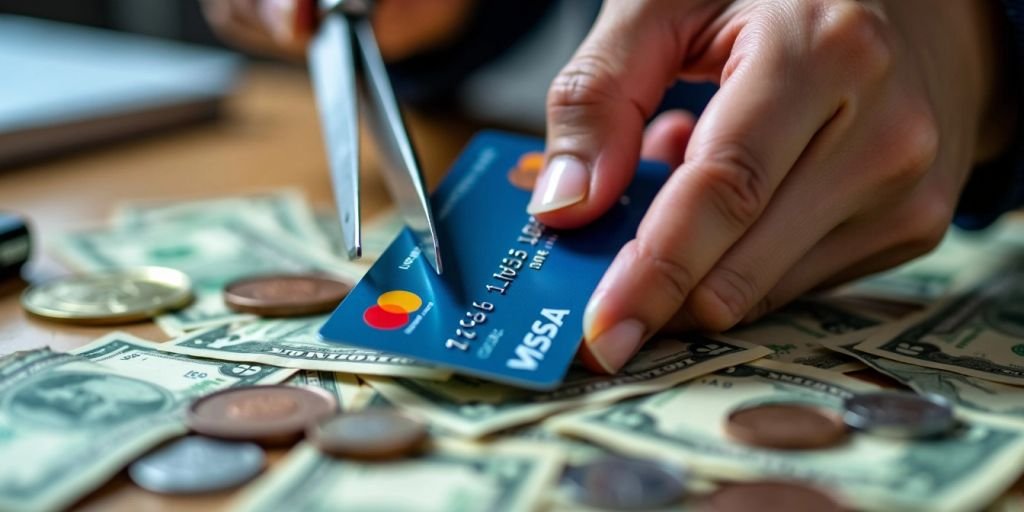Managing debt can feel overwhelming, but with the right strategies, you can take control of your finances. This guide will help you understand your debt situation, create a plan, and stay motivated as you work towards becoming debt-free. By following these steps, you’ll be on your way to a brighter financial future.
Key Takeaways
- Understand your total debt and prioritize high-interest loans.
- Create a clear debt-reduction plan with achievable goals.
- Implement budgeting techniques to track and reduce expenses.
- Explore debt-relief options if necessary, like consolidation or counseling.
- Stay disciplined and motivated to avoid new debt and celebrate your progress.
Understanding Your Debt Situation
Understanding your debt is the first step to getting control of your finances. Knowing exactly what you owe helps you make better decisions about how to pay it off. Here are some key areas to focus on:
Assessing Your Total Debt
To start, list all your debts. Include:
- The total amount owed
- Interest rates
- Minimum monthly payments
- Due dates
This will give you a clear picture of your financial situation. You can use a simple table to organize this information:
| Debt Type | Total Owed | Interest Rate | Minimum Payment | Due Date |
|---|---|---|---|---|
| Credit Card 1 | $1,200 | 18% | $50 | 15th |
| Student Loan | $5,000 | 5% | $100 | 1st |
| Car Loan | $8,000 | 7% | $200 | 10th |
Identifying High-Interest Debts
Next, focus on high-interest debts. These are the debts that cost you the most money over time. Paying these off first can save you money in the long run.
Evaluating Your Monthly Budget
Finally, take a close look at your monthly budget. Calculate your necessary expenses, like:
- Rent or mortgage
- Utilities
- Food
- Transportation
After listing these, see how much money you have left for discretionary spending. This leftover amount can be redirected to pay down your debts faster.
Understanding your debt situation is crucial. It helps you prioritize payments and create a plan to become debt-free.
By following these steps, you can gain control over your finances and start your journey toward a debt-free life.
Creating a Debt-Reduction Plan
Setting Clear Financial Goals
To effectively reduce your debt, set clear financial goals. This means knowing exactly how much you want to pay off and by when. Write down your goals and keep them visible to stay motivated.
Choosing a Debt-Reduction Strategy
There are different strategies to tackle your debt. Here are a few popular ones:
- Debt Snowball Method: Pay off your smallest debts first to gain momentum.
- Debt Avalanche Method: Focus on paying off debts with the highest interest rates first.
- Debt Management Plan: Work with a credit counselor to lower interest rates and consolidate payments.
Developing a Realistic Timeline
Creating a timeline is crucial. Break down your goals into smaller, manageable steps. For example, if you want to pay off $5,000 in a year, aim to pay about $417 each month. This makes your goal feel more achievable.
Remember, consistency is key. Stick to your plan and adjust as needed to stay on track.
By following these steps, you can create a solid plan to tackle your debt effectively. Understanding your total debt and making a plan is the first step toward financial freedom!
Implementing Budgeting Techniques

Tracking Your Expenses
To effectively manage your finances, keeping track of your spending is crucial. Start by listing all your monthly expenses, including fixed costs like rent and variable costs like groceries. You can use a simple table to organize this information:
| Expense Type | Amount |
|---|---|
| Rent | $1,200 |
| Groceries | $300 |
| Utilities | $150 |
| Transportation | $100 |
| Entertainment | $200 |
| Total | $1,950 |
Cutting Unnecessary Costs
Once you know where your money goes, look for areas to cut back. Here are some ideas:
- Cancel unused subscriptions.
- Limit dining out to once a week.
- Shop for groceries with a list to avoid impulse buys.
Allocating Funds for Debt Repayment
After identifying your essential expenses, allocate a portion of your income specifically for debt repayment. This can be a fixed amount each month or a percentage of your income. Prioritizing debt repayment helps you stay focused on becoming debt-free.
Remember, a budget is not just about restricting spending; it’s about making your money work for you.
By implementing these budgeting techniques, you can take control of your finances and make significant progress in reducing your debt. Stay committed, and adjust your budget as needed to meet your goals!
Exploring Debt-Relief Options
When you find yourself struggling with debt, it’s important to know that there are options available to help lighten your load. Debt relief can change the terms of your debt, making it easier to manage. Here are some common methods:
Debt Consolidation
Debt consolidation involves combining multiple debts into a single loan, often with a lower interest rate. This can simplify your payments and potentially reduce your monthly costs. Here’s a quick look at how it works:
| Type of Debt | Interest Rate | Monthly Payment |
|---|---|---|
| Credit Card | 18% | $300 |
| Personal Loan | 12% | $200 |
| Total | – | $500 |
By consolidating, you might end up with a single payment that’s easier to manage.
Credit Counseling Services
Credit counseling services can help you create a plan to pay off your debts. They work with you to lower interest rates and set up a manageable payment plan. Here’s what to expect:
- Free initial consultation
- Budgeting assistance
- Negotiation with creditors
Debt Settlement Programs
Debt settlement involves negotiating with creditors to reduce the total amount you owe. This can be a good option if you can’t pay your debts in full. However, it’s important to be cautious:
- Potentially lower your credit score
- May involve fees
- Can be complex
Remember, exploring these options can help you find a path to financial freedom. It’s essential to choose the right method that fits your situation.
By understanding these debt-relief options, you can take steps toward a more manageable financial future. Always consider your personal circumstances and seek professional advice if needed.
Maintaining Financial Discipline
Staying on track with your debt-reduction journey requires strong financial discipline. Here are some key strategies to help you maintain that discipline:
Avoiding New Debt
- Resist the urge to take on new loans or credit cards while paying off existing debts. This will help you focus on reducing what you already owe.
- Consider using cash or debit cards for purchases to avoid accumulating more debt.
Building an Emergency Fund
- Aim to save at least three to six months’ worth of living expenses. This fund can help you avoid new debt in case of unexpected expenses.
- Start small; even saving a little each month can add up over time.
Monitoring Your Progress
- Regularly check your debt balances and budget to see how much progress you’ve made. This can motivate you to keep going.
- Create a simple table to track your debt reduction:
| Month | Debt Amount | Amount Paid | Remaining Debt |
|---|---|---|---|
| Jan | $5,000 | $500 | $4,500 |
| Feb | $4,500 | $600 | $3,900 |
| Mar | $3,900 | $700 | $3,200 |
Remember: Every small step counts in your journey to becoming debt-free. Stay focused and committed to your goals!
Leveraging Financial Tools and Resources

Managing debt can be easier with the right tools and resources. Here are some effective ways to help you stay on track:
Using Budgeting Apps
Budgeting apps can help you keep an eye on your spending and savings. Some popular options include:
- Mint: Tracks your expenses and helps you create a budget.
- YNAB (You Need A Budget): Focuses on proactive budgeting to help you save.
- EveryDollar: A simple app for creating monthly budgets.
Seeking Professional Advice
Sometimes, getting help from a professional can make a big difference. Consider:
- Financial Advisors: They can provide personalized plans to manage your debt.
- Credit Counselors: They offer advice on budgeting and debt management.
- Debt Negotiators: They can help you negotiate lower payments with creditors.
Utilizing Online Calculators
Online calculators can help you understand your financial situation better. Here are a few to consider:
- Debt Payoff Calculator: See how long it will take to pay off your debt.
- Budget Calculator: Helps you create a budget based on your income and expenses.
- Savings Goal Calculator: Set and track your savings goals.
Remember, using these tools can help you stay organized and focused on your debt-reduction journey.
By leveraging these financial tools and resources, you can create a solid plan to tackle your debt effectively. Implementing these strategies can lead to significant progress in your journey to financial freedom.
Staying Motivated Throughout the Process
Staying motivated while paying off debt can be challenging, but it’s essential for success. Here are some strategies to help you keep your spirits high:
Celebrating Small Wins
- Acknowledge your progress: Every time you pay off a debt or reach a milestone, take a moment to celebrate. This could be as simple as treating yourself to a favorite snack or enjoying a movie night.
- Set mini-goals: Break your larger debt into smaller, manageable goals. Each time you achieve one, reward yourself in a small way.
Finding Support Networks
- Join a group: Look for local or online support groups where you can share your journey and hear from others who are also working to reduce their debt.
- Talk to friends and family: Share your goals with loved ones. Their encouragement can help keep you motivated.
Visualizing Your Debt-Free Future
- Create a vision board: Use images and words that represent your goals and dreams for a debt-free life. Place it somewhere you’ll see it daily.
- Write down your reasons: Keep a list of why you want to be debt-free. Refer to it when you feel discouraged.
Remember, staying focused on your goals can make a big difference. The journey may be tough, but each step brings you closer to financial freedom.
By implementing these strategies, you can maintain your motivation and keep moving forward on your path to becoming debt-free. Don’t forget to use the debt snowball method to help you stay engaged and see results quickly!
Conclusion
In summary, getting out of debt is a journey that requires careful planning and commitment. Start by understanding your total debt and creating a budget that works for you. Use strategies like the debt snowball or debt avalanche methods to tackle your debts effectively. Remember, it’s important to cut unnecessary expenses and possibly find ways to earn extra money. Stay focused and patient, as paying off debt takes time. With determination and the right approach, you can achieve a debt-free life.
Frequently Asked Questions
What is the first step in reducing my debt?
The first step is to understand how much debt you have. List all your debts, including their amounts and interest rates. This will help you see your financial situation clearly.
What is the debt snowball method?
The debt snowball method means paying off your smallest debts first. You make minimum payments on all debts but focus extra money on the smallest one until it’s paid off.
How can I create a budget to help pay off my debt?
To create a budget, track your income and expenses. Cut back on non-essential spending, and allocate more money towards paying off your debts.
What are some debt relief options?
Some options include debt consolidation, credit counseling, and debt settlement. Each has its pros and cons, so it’s important to research them.
How can I stay motivated while paying off debt?
Celebrate small victories along the way. Join support groups or talk to friends who understand your journey to keep you motivated.
Is it better to use the debt avalanche method instead?
The debt avalanche method focuses on paying off debts with the highest interest rates first. It can save you money in interest, but it might take longer to see results.




